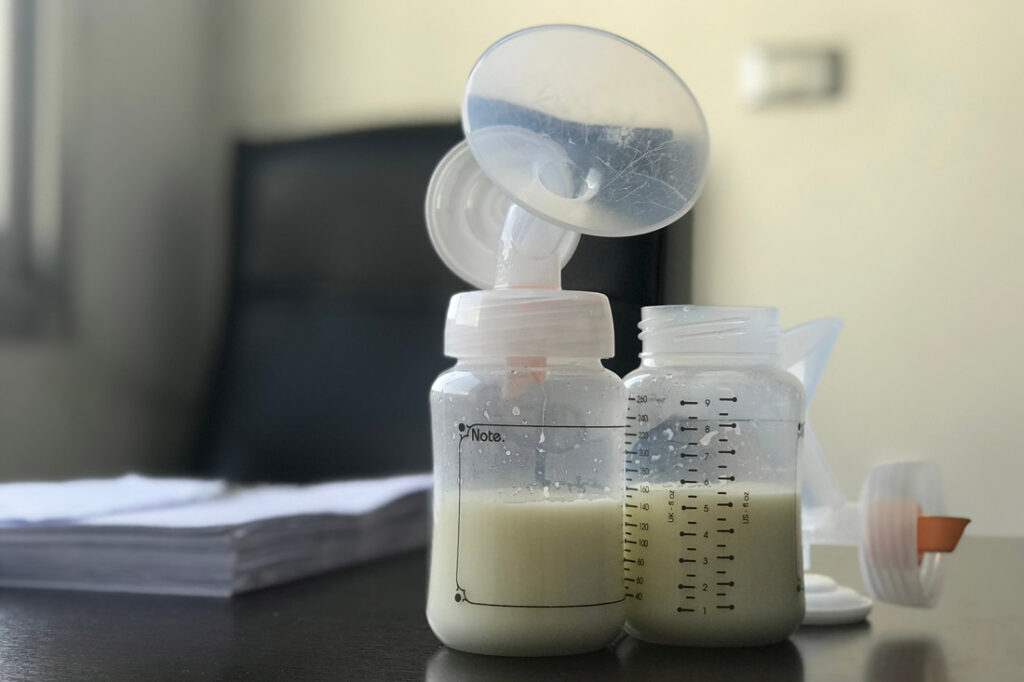As a young teacher trying to balance having my first of five babies with breastfeeding, pumping, grading papers and navigating work responsibilities (all while inspiring the kids of the future, of course), I had an incident.
I had just 20 minutes to pump breast milk on my “break” (read: my lunchtime), though a normal pumping session took 30 minutes, plus five minutes of set-up and tear down. There was no time for cleaning the pump, which I’d have to just worry about later in the day, before pumping on my car ride home. In addition to the rush, which sometimes led to literal spilled milk and half-eaten lunches, I was pumping in my classroom with a partial wall separating me from the next room, and a locked door with a sign keeping out 35 kids when the bell rang.
One day, the principal unlocked the door, passed the sign and let in a male high school student to retrieve his backpack. I was mortified, ducking under the desk a bit to hide my exposed breasts and pump. With a mumbled apology, they headed back out, leaving the door unlocked behind them. I had to teach that student two bells later.
Breastfeeding at work laws: The PUMP Act
This is the norm for many American mothers. One in three say they lack access to a reliable workplace lactation space, according to a large survey from Medela and Mamava of over 15,000 nursing parents. Other data from the survey points to a need for workplaces to lead the charge for change:
- More than 50% of breastfeeding parents are not aware of their own lactation rights in the workplace
- 47% don’t have enough time to pump at work
- 1 in 4 don’t feel supported at work
- 61% cite pumping logistics as a top challenge, from packing to transporting and cleaning pump parts on the go
Luckily for breastfeeding parents like myself—who have been pumping, nursing or pregnant for a decade (half of my working life)—there’s a new law supporting these needs, called the PUMP Act. This grants employees “reasonable break time” and a place to pump (that isn’t the bathroom) that’s shielded from view and free from intrusion by others, for one year after the child’s birth. Yet, the survey above reports only 15% of public places are supportive and ready for nursing parents. So, there’s work to do, and business leaders can lead the charge. Here’s how to help.
A little education on breastfeeding rights at work goes a long way
New moms don’t expect their bosses to be breastfeeding experts. But, it would go a long way for them to know some of the basics to better help their employees. This awareness can be part of the solution to more parents being able to sustain breastfeeding as long as they want to. The Centers for Disease Control and Prevention (CDC) shows many parents quit breastfeeding—around 4 in 5 parents start out breastfeeding, but by six months postpartum, only around half still are. A 2017 study from the International Journal of Women’s Health reported 3 in 4 mothers don’t believe they make enough milk, which can be hard to do if they don’t have sufficient pumping time.
“Although the benefits of breastfeeding are well-known, there is a great lack of information as to what breastfeeding is actually like,” says Dr. Jessica Madden, IBCLC, a board-certified neonatologist, pediatrician and lactation consultant. She’s also the medical director at Aeroflow Breastpumps and founder of Primrose Newborn Care.
“I don’t believe the general public has any idea how common it is for breastfeeding problems and complications to arise, how many parents actually struggle to produce milk for their babies, the time, energy and resources needed to be able to pump milk (to both nourish infants and toddlers and prevent decreases in milk supply during parent-infant separation), and the epidemic of postpartum mental health issues (depression and anxiety) we are currently in the midst of,” Madden explains.
Help provide enough time and a private space with a lactation room at work
You don’t need to build the fanciest pumping room around. But parents do need enough time and space. If you are prioritizing employee mental health care, this is a part of it. In fact, in an Aeroflow Breastpumps survey of 1,347 people, 67% attributed breastfeeding concerns to their postpartum mental health issues.
Here are five tips I wish my bosses had known that might help:
- To make enough milk, you have to be relaxed. You can’t be relaxed if you are rushed or not in a private space.
- Just like hungry babies, or when adults need to use the restroom, sometimes you need to pump at a different time than yesterday. Maybe the baby slept longer and ate later. Accommodating varying pumping schedules would be the best case scenario, and is also part of the PUMP Act.
- Access to a sink to clean pump parts is ideal and sanitary, especially if there’s a way to do this in private.
- If a pumping employee needs to leave abruptly, their breasts might be leaking. Don’t treat it any different than a bathroom emergency and let them go.
“Upon returning to work from maternity leave, the time allotted for a lactating parent to pump needs to be individualized. Some are able to successfully pump milk during 20-minute sessions three times per day, but many cannot,” Madden says. “For many, a pumping session takes closer to 40-45 minutes when you factor in walking to a dedicated breastfeeding/pumping space, setting up the pump and supplies, achieving letdown, fully emptying milk from both breasts, cleaning up oneself and the pump supplies, storing the pumped milk, using the restroom facilities (if needed) and returning to the work space.” In addition, breastfeeding parents need access to hydration and meal breaks so they can make milk, she adds.
Sascha Mayer, the co-founder and chief experience officer of Mamava, adds, “The law is intentionally vague about both the time and space requirements to allow for differences in biology (some people need to pump for 15 minutes, others might need 40 minutes) and workplace environments.”
Advice from a company who recently prioritized a lactation space at work
Brie Elliott, head of human resources at Ballentine, a financial firm with 125 employees in three states, says multiple employees expanded their families during the pandemic. Ballentine included this consideration in an employee audit of family-friendly benefits when they went back to the office.
“Our goal was to ensure that our team members had access to the necessary resources and support when in-office work and corporate travel resumed,” Elliott says. They chose to partner with pumpspotting, a community breastfeeding support platform and app that helps locate lactation spaces, gives virtual support and other benefits. Other companies have used consulting services like Mamava’s to learn how to install pods and build necessary spaces.
“Our primary aim was to ensure that this dedicated space was not just functional but also deeply considerate of the needs of those who would use it,” Elliott says. So, they got to work.
“We thoughtfully furnished it with essential amenities such as a refrigerator, sink, microwave, a cozy chair for comfort and adjustable uplighting to create a serene atmosphere. Since then we’ve added amenity baskets, which include items often needed while pumping,” she says. “We purposefully positioned this room at the far end of our office space, intentionally away from heavy foot traffic to provide privacy and tranquility.”
This year, the Los Angeles Department of Water and Power released its own comprehensive program for lactating employees, and included more than a room—the company also offers lactation consultant services and pumps to loan out.
It’s a retention strategy, protection against lawsuits and a basic human right
Elliott explains that for companies like hers who are prioritizing putting diverse employee needs first—with an eye for valuing their families, as well—this was a must, and is even part of a larger retention strategy. “We’re mindful of the concerning statistics indicating the impact of the COVID era on women in the workforce. In these challenging times, we aspire to be a place that attracts and retains top-tier talent.”
Mayer says that there’s a sad history when it comes to our slow progress to accommodate nursing women at work. “I think it is because it is a problem that goes away pretty quickly if a breastfeeding parent wasn’t supported at work. They did one of two things: quit the job or quit trying to breastfeed.”
She adds that the latter was the reality for many parents, and it’s easy to see when you look at how breastfeeding rates plummet when mothers return to work. Change at the employer level needs change at a structural/cultural level.
But things might be looking up, due to awareness and the law through which employees can sue if they aren’t accommodated, she says. Since Mamava began a decade ago, there’s been an increase in breastfeeding initiation rates of 10%, likely because companies are improving support. With employer involvement, hopefully it won’t take another decade to get a marginal improvement in a basic human right.
Photo by Biwary inthawong/Shutterstock.com





